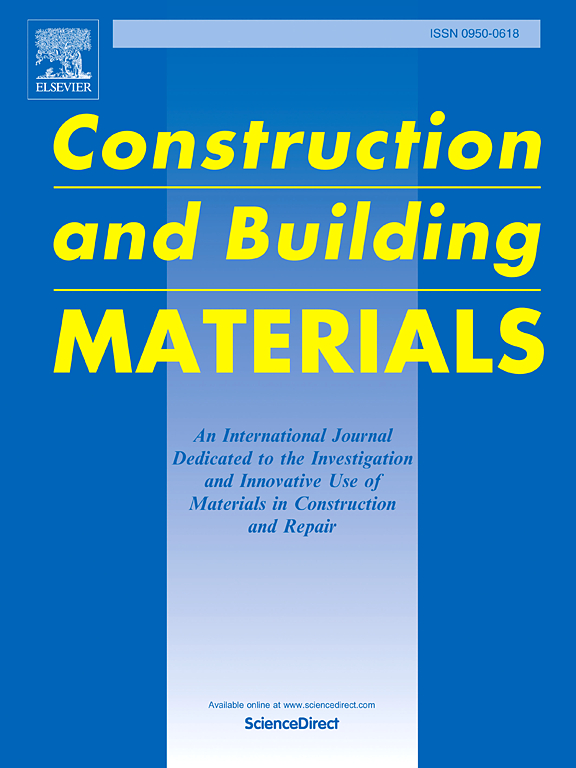用于文物古迹修复区结构健康监测的可持续石灰基纳米增强浆料
IF 7.4
1区 工程技术
Q1 CONSTRUCTION & BUILDING TECHNOLOGY
引用次数: 0
摘要
本文的目的是研究不同碳纳米结构生产的可持续性,这些碳纳米结构可用于加强石灰基砂浆,用于文化遗产古迹修复区域的结构健康监测。从制造成本、环境影响、力学性能和压阻响应等方面进行研究,在不同的多决策标准下选择可持续的碳纳米结构来增强石灰基砂浆。采用实验室规模的5种不同碳纳米结构(石墨烯- G和多壁碳纳米管- MWCNTs)的定量成本评估方法。这些结果被解释为对最终产品(例如纳米增强石灰基糊状物)的机械性能的各自增强。力学试验结果表明,改性后的MWCNTs由于增强纳米结构的锚固作用增加,使浆料的抗弯强度提高了109 %,而抗压强度基本没有受到影响。相反,由于其血小板几何形状和各自的载荷传递能力,改性石墨烯纳米结构仅提高了膏体的抗压强度29% %。还原石墨烯(rGO)的高制造成本为2.62欧元/g,这与所使用的原材料成本高有关,而氧化石墨烯(GO)的制造成本为1.37欧元/g,主要是由于材料成本和人工成本的平衡贡献。这些纳米结构被计算为具有最低的环境影响(0.10 kg CO2eq/g),而羧基化过程基本上增加了大约(8 x) 8倍的等效碳足迹(0.83 kg CO2eq/g)。在大多数情况下,氧化石墨烯在不同的碳纳米结构中表现优异,因为它在几个标准上的值很低,比如每制造成本的机械性能或每碳足迹的机械性能,并且在循环压缩机械载荷下表现出最佳的压阻响应。因此,它被证明是最具可持续性的碳纳米结构,可用于相关应用。本文章由计算机程序翻译,如有差异,请以英文原文为准。
Sustainable lime-based nano-reinforced pastes for structural health monitoring of the restoration areas of Monuments of Cultural Heritage
The aim of the present article is to investigate the sustainability of the production of different carbon-nanostructures that can be used to reinforce lime-based mortars for structural health monitoring of the restoration areas in Monuments of Cultural Heritage. Aspects like manufacturing cost, environmental impact, mechanical properties, and piezo-resistive response were investigated to select a sustainable carbon nanostructure to reinforce lime-based mortars under different, multi-decision criteria. A quantitative cost assessment methodology for five (5) different carbon nanostructures (graphene - G and multi-wall carbon nanotubes - MWCNTs) in laboratory-scale was adopted. The results were interpreted against the respective enhancement on the mechanical properties resulted on the end-products, e.g., the nano-reinforced lime-based pastes. The mechanical tests results showed that the modified MWCNTs enhanced flexural strength by 109 % due to increased anchoring of the reinforcing nanostructures in the paste, while compressive strength was not essentially affected. On the contrary, the modified graphene nanostructures enhanced only the compressive strength of the paste by 29 % due to their platelet geometry and their respective load transfer capability. The high manufacturing cost of reduced graphene (rGO) 2.62 €/g is related to the high cost of raw materials utilized, while graphene oxide (GO) has a manufacturing cost of 1.37 €/g, mainly due to the balanced contribution of material and labour cost, respectively. These nanostructures were calculated to have the lowest environmental impact (0.10 kg CO2eq/g), while the carboxylation process increased essentially the equivalent carbon footprint by approximately (8 x) eight times (0.83 kg CO2eq/g). In most cases, GO excel among the different carbon nanostructures studied, due to its low values in several criteria, like mechanical properties per manufacturing cost or mechanical properties per carbon footprint, as well as showed the best piezo-resistive response to cyclic compressive mechanical loads. To this end, it proved to be the most sustainable carbon nanostructure to be exploited in relevant applications.
求助全文
通过发布文献求助,成功后即可免费获取论文全文。
去求助
来源期刊

Construction and Building Materials
工程技术-材料科学:综合
CiteScore
13.80
自引率
21.60%
发文量
3632
审稿时长
82 days
期刊介绍:
Construction and Building Materials offers an international platform for sharing innovative and original research and development in the realm of construction and building materials, along with their practical applications in new projects and repair practices. The journal publishes a diverse array of pioneering research and application papers, detailing laboratory investigations and, to a limited extent, numerical analyses or reports on full-scale projects. Multi-part papers are discouraged.
Additionally, Construction and Building Materials features comprehensive case studies and insightful review articles that contribute to new insights in the field. Our focus is on papers related to construction materials, excluding those on structural engineering, geotechnics, and unbound highway layers. Covered materials and technologies encompass cement, concrete reinforcement, bricks and mortars, additives, corrosion technology, ceramics, timber, steel, polymers, glass fibers, recycled materials, bamboo, rammed earth, non-conventional building materials, bituminous materials, and applications in railway materials.
 求助内容:
求助内容: 应助结果提醒方式:
应助结果提醒方式:


